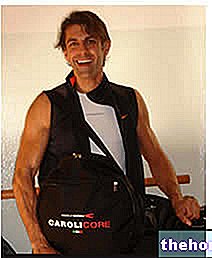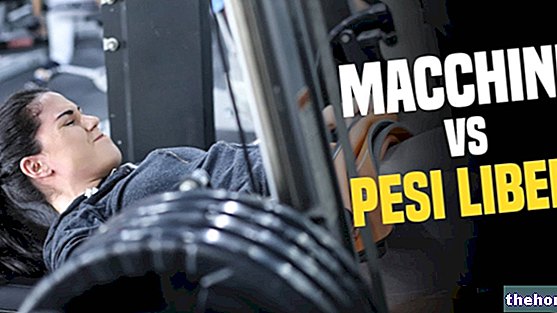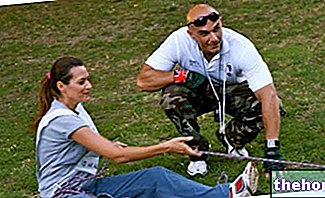Edited by: Baccaglini Gabriele
Many regular gym-goers argue that the flat bench is not the ultimate in developing pectoral muscles, effectively colliding with those who argue that there is no better exercise to forge a massive chest.
The resigned opinion of the former often derives from a very bad direct experience, since testing on themselves the exercise of the bench press, they did not obtain the desired results.

In fact, the pushes on a flat bench, unlike movements similar to machines, are real athletic movements and as such have their own precise form of execution, outside of which the exercise becomes less effective, more uncomfortable and also more dangerous. A bad bench press technique will not only waste time, but can easily lead to serious injuries.
In this short article I will try to illustrate the key points for an optimal (and productive) execution of the bench press, even for those who have chosen it as a tool for the home gym.
Let's start from the bottom
As irrelevant as it may seem, the position of the feet is actually very important in a good bench lift. In fact, the balance of the whole body depends on their solid support: if you don't believe it, try to perform the usual flat bench press with your thighs raised. You will immediately notice that the sense of insecurity and the easy imbalance will affect your thrust. To optimize this factor. place the entire soles of your feet firmly on the ground (if you don't get there, put wooden raisers or discs on the ground) and push against the floor, almost as if you want to lift your pelvis, but without doing so. This device will discharge the destabilizing forces through your legs and you will enjoy a rock solid base.
The back
In gyms you often see the guy who arches his back to make his lift until he detaches his butt from the bench and leans 30 ° with respect to it. WRONG. This is a technique used by powerlifters for supermassive loads and it is very risky, those who know how to use it do it only for competitions and it is certainly not useful for bodybuilding! This position brings the spine into a marked lordosis, creating a violent compression of the vertebral rings with the risk of seriously damaging them. Correct execution requires a slight accentuation of the lumbar lordosis but always placing the weight of the body on the buttocks and feet. Wearing a weightlifting belt can help with heavier loads but it absolutely does not authorize you to take your attention off your back; rather, don't use it.
Shoulders
The average beginner tends to shrug their shoulders when performing the bench press, as if to "shrug." This movement is useless as it instinctively leads to contracting the upper trapezius, subtracting precious energy from our lifting. Then, shoulders relaxed down.
Shoulders
Another typical mistake of the amateur is to accompany the barbell with the shoulder during the vertical thrust. In practice, if at the start the shoulders are adherent to the bench, about halfway through the movement they "detach" to push the barbell in a dirty way for those 2-3 cm higher. This makes the pectoral work in shortening and passes a lot of work to the anterior deltoid which, in addition to not being our target muscle, is of modest size and therefore weak: the thrust will suffer a sudden stop and the exercise will cease when the latter is "exhausted".
The perfect movement requires shoulder blades contracted backwards to close in the middle of the back the whole duration of the lift and return. By doing so, at the point where the barbell is lowest, the pectoral will be widely extended, a position in which it develops the maximum strength and in which it receives the maximum stimulus for growth. At the end of the movement with the shoulders motionless in the same starting position, the chest will be the only muscle really under load, with no other groups providing it with "support" making the exercise lose its usefulness.
Elbows
Bringing the elbows too far out (tending to align them with the shoulders) transfers a lot of the effort to the anterior deltoid which, as already mentioned, weakens the lift by limiting load and involvement of the chest. The elbows must remain naturally open below the bar.
Sternum
The sternum must be grazed by the barbell, not "hammered". Absolutely no to rebounds, an indication of failure to control the load (you are lifting too much weight). Even stopping 3-4 cm before touching the chest is not good because you lose a part (the most important) of movement in which the chest stretches more. See: Pectoral Flexibility Test.
Hands
Hands should squeeze the bar, not "hold" it. You have to master the load, not be dominated by it. The wrist should not be bent with respect to the forearm but as much in line with it as possible (for this you have to squeeze the bar). The rod must release the force between the thumb and forefinger while all the fingers lock it. A secure grip is essential to move the weight correctly.
Head
Keep it resting on the bench, avoid detaching it. The more movements out of the lift you make, the more energy is lost. Also, keeping your head up will make it harder for you to breathe.
CONTINUE: Flat bench: the correct technique "




























